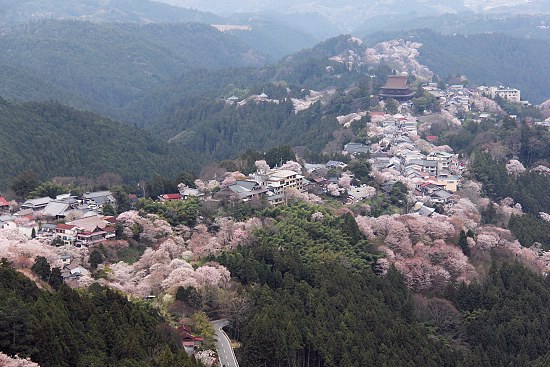Cherry Blossoms 2012: Yoshino Report (4/16)
| Cherry Blossom Report 2012 Official cherry blossom reports by japan-guide.com |
| previous post |
| next post |
2012/04/16 - Yoshino Report
by schauwecker

With 30,000 trees and a history stretching back more than a thousand years, Mount Yoshino or Yoshinoyama is Japan's most celebrated cherry blossom spot. The mountain is divided into four sections from bottom to top: Shimosenbon ("Lower 1000 Trees"), Nakasenbon ("Middle 1000 Trees"), Kamisenbon ("Upper 1000 Trees") and Okusenbon ("Innermost 1000 Trees").
The trees started to open their blossoms in the lower area on April 9 this year - a late start compared to the average year. Today, the lower and middle areas were already at full bloom, and the upper area is expected to follow within two days. If the weather cooperates, the entire week should provide spectacular cherry blossom viewing conditions at Yoshinoyama.
The trees in the innermost area in the back of the mountain bloom considerably later and are not expected to reach full bloom until April 25. Moreover, the innermost area does not offer the same spectacular views that the lower three sections are famous for.
Shimosenbon (Lower 1000 Trees)
April 16, 2012 - full bloom
The trees in the lower section have reached full bloom. Their blossoms still looked sturdy and should remain attractive for several days to come. If the weather cooperates, quite a few petals could hang on even into the next weekend.




Unlike most other hanami spots in Japan - and somewhat ironically - Yoshinoyama is not dominated by the Somei Yoshino variety of cherry trees. Instead, the most numerous tree is the Yamazakura, one of Japan's native trees that actually grows in nature as opposed to human made cultivars like the Somei Yoshino.
Yamazakura blossoms are smaller and less numerous than Somei Yoshino blossoms. Furthermore, Yamazakura trees develop their coppery leaves almost simultaneously with their blossoms, giving them a less intensive look. In groups with other cherry tree varieties, they create the wonderful clouds of slightly differing hues of pink that Yoshinoyama is loved for.


Nakasenbon (Middle 1000 Trees)
April 16, 2012 - full bloom
The trees in the middle section have also reached full bloom today. One of the best and most famous views of the mountain can be enjoyed from the grounds of Yoshimizu Shrine.

I also checked out the onsen bath of the Yumoto Honoya, one of several hotels along the slopes of Yoshinoyama. From the small, gender segregated outdoor baths it is possible to look over the sea of cherry blossoms while bathing (11:30 to 15:00 in April, 1500 yen/person for non-staying guests). What an enjoyable way to do hanami!



Kamisenbon (Upper 1000 Trees)
April 16, 2012 - approaching full bloom (50-80%)
After passing the middle area, the road up the mountain suddenly becomes steeper. This is where the upper area starts. It was difficult to generalize the state of the trees in the upper area because of the wide range of altitude (about 200 meters) and the various tree varieties present. While some trees were already at full bloom, others still had their buds closed. Overall, the trees were opening up quickly and most should reach full bloom within just a couple of days.

Chikurin-in Temple at the entrance to the upper area has a garden with early blooming weeping cherry trees that stood at full bloom. If you make it up all the way the upper area, do not miss the Hanayagura View Point with splendid views down the entire mountain.



Due to its tremendous popularity, Yoshinoyama gets very crowded even on regular weekdays. Most of the lower and middle areas of the mountain are closed to car traffic between 9:00 and 19:00, but in the upper area pedestrians have to look out for cars (except on weekends).
For those unwilling or unable to climb the entire mountain, there are shuttle buses that operate between Yoshino Station and the middle area and between Chikurin-in Temple and the innermost area until May 6. For a comfortable ride to/from Yoshino, I recommend to make seat reservations for a Kintetsu limited express train in advance.


| previous post |
| next post |
Questions? Ask in our forum.